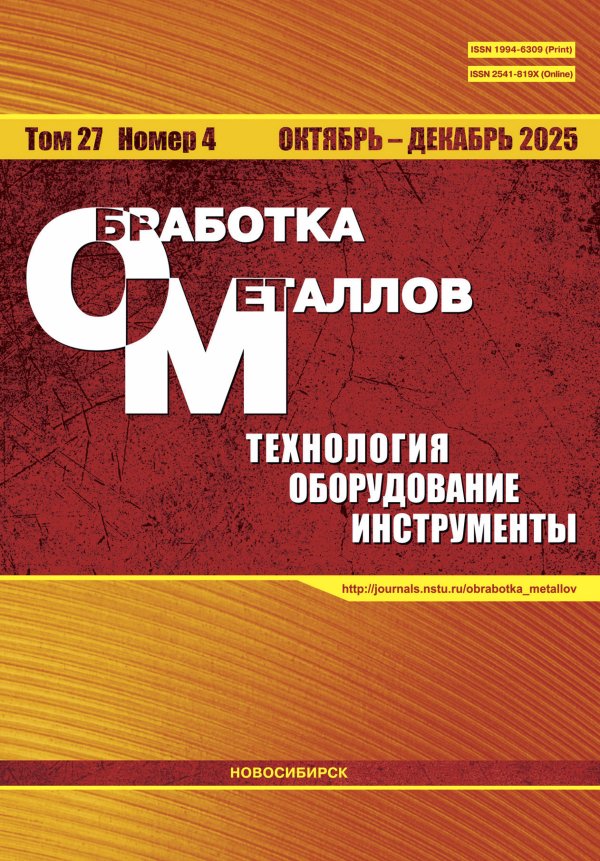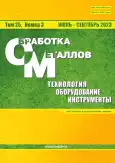Экспериментальные исследования режимов скоростного шлифования рельсов
- Авторы: Ильиных А.С.1, Пикалов А.С.1, Милорадович В.К.1, Галай М.С.1
-
Учреждения:
- Выпуск: Том 25, № 3 (2023)
- Страницы: 19-35
- Раздел: ТЕХНОЛОГИЯ
- URL: https://bakhtiniada.ru/1994-6309/article/view/301448
- DOI: https://doi.org/10.17212/1994-6309-2023-25.3-19-35
- ID: 301448
Цитировать
Аннотация
Ключевые слова
Об авторах
А. С. Ильиных
Email: asi@stu.ru
доктор техн. наук, доцент, Сибирский государственный университет путей сообщения, ул. Дуси Ковальчук, 191, 630049, Россия, asi@stu.ru
А. С. Пикалов
Email: pikalov.2023@internet.ru
канд. техн. наук, Центр инфраструктурных технологий АО «СТМ», Москва, Подкопаевский переулок, д. 4Б, 109028, Россия, pikalov.2023@internet.ru
В. К. Милорадович
Email: vmiloradovich@internet.ru
Центр инфраструктурных технологий АО «СТМ», Москва, Подкопаевский переулок, д. 4Б, 109028, Россия, vmiloradovich@internet.ru
М. С. Галай
Email: galayms@mail.ru
канд. техн. наук, Сибирский государственный университет путей сообщения, ул. Дуси Ковальчук, 191, 630049, Россия, galayms@mail.ru
Список литературы
- Fan W., Liu Y., Li J. Development status and prospect of rail grinding technology for high speed railway // Journal of Mechanical Engineering. – 2018. – Vol. 54, iss. 22. – P. 184–193. – doi: 10.3901/JME.2018.22.184.
- Schoch W. Grinding of rails on high-speed railway lines: a matter of great importance // Rail Engineering International. – 2007. – Vol. 36, iss. 1. – P. 6–8.
- Funke H. Rail grinding. – Berlin: Transpress, 1986. – 153 p.
- Cuervo P., Santa J., Toro A. Correlations between wear mechanisms and rail grinding operations in a commercial railroad // Tribology International. – 2015. – Vol. 2. – P. 265–273. – doi: 10.1016/j.triboint.2014.06.025.
- Long term rail surface damage considering maintenance interventions / V. Krishna, S. Hossein-Nia, C. Casanueva, S. Stichel // Wear. – 2020. – Vol. 460–461. – P. 203462. – doi: 10.1016/j.wear.2020.203462.
- Application of grinding to reduce rail side wear in straight track / J. Ding, R. Lewis, A. Beagles, J. Wang // Wear. – 2018. – Vol. 402–403. – P. 71–79. – doi: 10.1016/j.wear.2018.02.001.
- Ilinykh A., Matafonov A., Yurkova E. Efficiency of the production process of grinding rails on the basis of optimizing the periodicity of works // Advances in Intelligent Systems and Computing. – 2019. – Vol. 1116. – P. 672–681. – doi: 10.1007/978-3-030-37919-3_67.
- Ильиных А.С. Скоростное шлифование рельсов в пути // Мир транспорта. – 2011. – № 3. – С. 56–61.
- Повышение производительности рельсошлифовальных поездов методом скоростного шлифования / А.С. Ильиных, А.С. Пикалов, М.С. Галай, В.К. Милорадович // Известия высших учебных заведений. Северо-Кавказский регион. Технические науки. – 2022. – № 4 (216). – С. 46–56. – doi: 10.17213/15603644202244656.
- Doman D., Warkentin A., Bauer R. A survey of recent grinding wheel topography models // International Journal of Machine Tools & Manufacture. – 2006. – Vol. 46, iss. 3. – P. 343–352. – doi: 10.1016/j.ijmachtools.2005.05.013.
- Experimental observation of tool wear in rotary ultrasonic machining of advanced ceramics / W. Zenga, Z. Lib, Z. Peib, C. Treadwell // International Journal of Machine Tools & Manufacture. – 2005. – Vol. 45, iss. 12–13. – P. 1468–1473.
- Jeong W., Shin J. Grinding effect analysis according to control variables of compact rail surface grinding machine // Journal of the Korean Society for Railway. – 2020. – Vol. 23, iss. 7. – P. 688–695. – doi: 10.7782/JKSR.2020.23.7.688.
- Koshin A.A., Chaplygin B.A., Isakov D.V. Adequacy of the operating conditions of abrasive grains // Russian Engineering Research. – 2011. – Vol. 31, N 12. – P. 1221–1226.
- Особенности формирования технологического процесса плоского шлифования торцом круга при упругой подвеске шлифовальной головки / А.С. Ильиных, В.А. Аксенов, М.С. Галай, А.В. Матафонов // Вестник Пермского национального исследовательского политехнического университета. Машиностроение, материаловедение. – 2016. – Т. 18, № 4. – C. 34–47. – doi: 10.15593/2224-9877/2016.4.03.
- A laboratory demonstration of rail grinding and analysis of running roughness and wear / M. Mesaritis, M. Shamsa, P. Cuervo, J. Santa, A. Toro, M. Marshall, R. Lewis // Wear. – 2020. – Vol. 456–457. – doi: 10.1016/j.wear.2020.203379.
- Satoh Y., Iwafuchi K. Effect of rail grinding on rolling contact fatigue in railway rail used in conventional line in Japan // Wear. – 2008. – Vol. 265, iss. 9–10. – P. 1342–1348. – doi: 10.1016/j.wear.2008.02.036.
- Modelling and simulation of the grinding force in rail grinding that considers the swing angle of the grinding stone / K. Zhou, H. Ding, S. Zhang, J. Guo, Q. Liu, W. Wang // Tribology International. – 2019. – Vol. 137. – P. 274–288. – doi: 10.1016/j.triboint.2019.05.012.
- Experimental investigation on material removal mechanism during rail grinding at different forward speeds / K. Zhou, H. Ding, R. Wang, J. Yang, J. Guo, Q. Liu, W. Wang // Tribology International. – 2020. – Vol. 143. – P. 106040. – doi: 10.1016/j.triboint.2019.106040.
- Influence of rail grinding process parameters on rail surface roughness and surface layer hardness / E. Uhlmann, P. Lypovka, L. Hochschild, N. Schröer // Wear. – 2016. – Vol. 366–367. – P. 287–293. – doi: 10.1016/j.wear.2016.03.023.
- Jeong W., Shin J. Grinding effect analysis according to control variables of compact rail surface grinding machine // Journal of the Korean Society for Railway. – 2020. – Vol. 23, iss. 7. – P. 688 – 695. – doi: 10.7782/JKSR.2020.23.7.688.
- Ilinykh A.S. Design of abrasive tool for high-rate grinding // IOP Conference Series: Earth and Environmental Science. – 2017. – Vol. 53. – P. 012024. – doi: 10.1088/1755-1315/53/1/012024.
Дополнительные файлы







